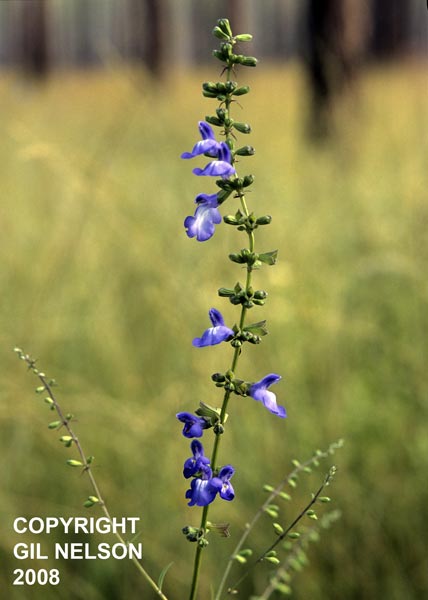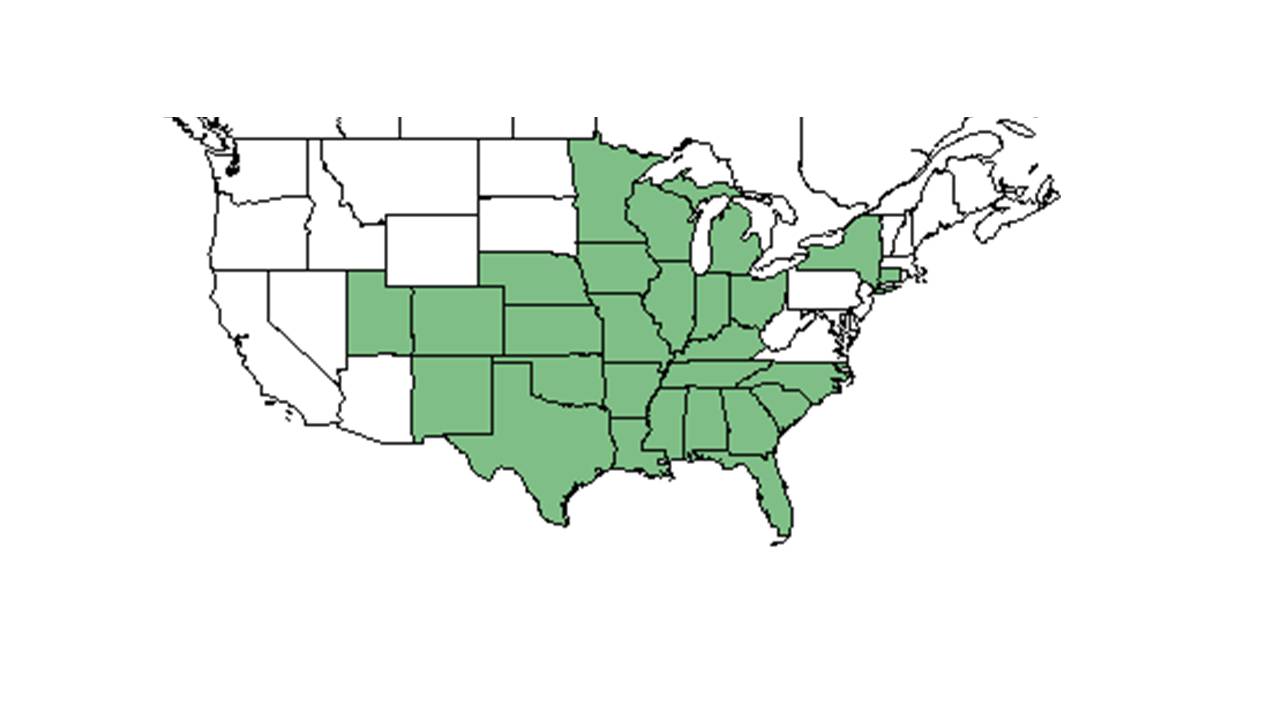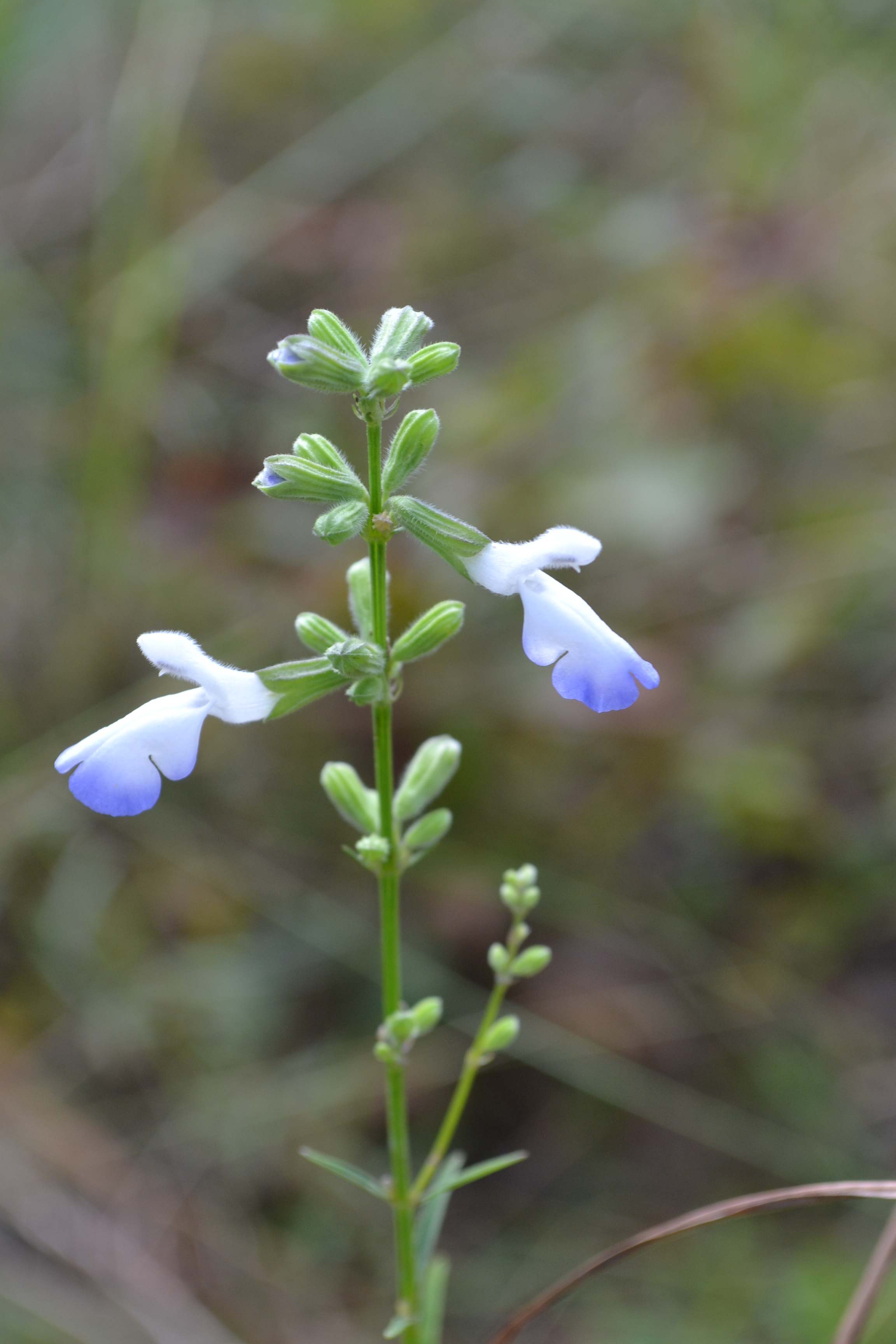Difference between revisions of "Salvia azurea"
Lsandstrum (talk | contribs) |
HaleighJoM (talk | contribs) (→Ecology) |
||
| (20 intermediate revisions by 6 users not shown) | |||
| Line 20: | Line 20: | ||
Common names: Azure blue sage, Azure sage | Common names: Azure blue sage, Azure sage | ||
==Taxonomic notes== | ==Taxonomic notes== | ||
| − | Synonym: ''Salvia pitcheri'' Torrey ex Bentham | + | Synonym: ''Salvia pitcheri'' Torrey ex Bentham |
| + | |||
| + | Subspecies: ''Salvia azurea'' Michaux ex Lamarck ssp. ''pitcheri'' (Torrey ex Bentham) Epling | ||
Variety: ''Salvia azurea'' Michaux ex Lamarck var. ''grandiflora'' Bentham; ''Salvia azurea'' Michaux ex Lamarck var. ''azurea'' | Variety: ''Salvia azurea'' Michaux ex Lamarck var. ''grandiflora'' Bentham; ''Salvia azurea'' Michaux ex Lamarck var. ''azurea'' | ||
| Line 26: | Line 28: | ||
==Description== | ==Description== | ||
<!-- Basic life history facts such as annual/perrenial, monoecious/dioecious, root morphology, seed type, etc. --> | <!-- Basic life history facts such as annual/perrenial, monoecious/dioecious, root morphology, seed type, etc. --> | ||
| − | Azurea means "sky blue" referring to the color of the flower; however, some individuals may have white colored flowers. <ref name="Nelson 2005">Nelson, Gil. Atlantic Coastal Plain Wildflowers: A Field Guide to the Wildflowers of the Coastal Regions of Virginia, North Carolina, South Carolina, Georgia, and Northeastern Florida. Guilford, CT: FalconGuide, 2006. 54. Print.</ref> The corolla is typically white or white with blue tint near the petal tips in northern Florida and southern Georgia ([[KMR]]). | + | Azurea means "sky blue" referring to the color of the flower; however, some individuals may have white colored flowers.<ref name="Nelson 2005">Nelson, Gil. Atlantic Coastal Plain Wildflowers: A Field Guide to the Wildflowers of the Coastal Regions of Virginia, North Carolina, South Carolina, Georgia, and Northeastern Florida. Guilford, CT: FalconGuide, 2006. 54. Print.</ref> The corolla is typically white or white with blue tint near the petal tips in northern Florida and southern Georgia ([[KMR]]). |
| − | "Perennial, [or annual] herbs [or shrubs], with erect to ascending quadrangular stems. Leaves toothed or lobed. Inflorescent a thryse, cymules 3-15 flowered. Calyx zygomorphic, 2-lipped; corolla zygomorphic, 2-lipped, blue to violet or red, rarely white. Fertile stamens 2, exserted, sterile stamens present or absent; stigma unequally 2-cleft, exserted." <ref name="Radford et al 1964">Radford, Albert E., Harry E. Ahles, and C. Ritchie Bell. Manual of the Vascular Flora of the Carolinas. 1964, 1968. The University of North Carolina Press. 913. Print.</ref> | + | "Perennial, [or annual] herbs [or shrubs], with erect to ascending quadrangular stems. Leaves toothed or lobed. Inflorescent a thryse, cymules 3-15 flowered. Calyx zygomorphic, 2-lipped; corolla zygomorphic, 2-lipped, blue to violet or red, rarely white. Fertile stamens 2, exserted, sterile stamens present or absent; stigma unequally 2-cleft, exserted."<ref name="Radford et al 1964">Radford, Albert E., Harry E. Ahles, and C. Ritchie Bell. Manual of the Vascular Flora of the Carolinas. 1964, 1968. The University of North Carolina Press. 913. Print.</ref> |
| − | "Stems 0.7-1.5 m tall, 1-several from a crown, leafy simple or branched above, basal leaves absent. Leaves linear, narrowly elliptic to elliptic-lanceolate, 4-8.5 cm long, 0.3-3 cm wide, acute to obtuse, entire to crenate-serrate, base cuneate to attenuate, petioles obscured by decurrent blade. Calyx 5-8 mm long, upper lip entire, lower 2-toothed, teeth acute, not bristle tipped; corolla blue, 1.3-1.5 cm long; the 2 locules of each anther side by side. Mericarps olive-brown, resinous-glandular, dull, ellipsoid to obovoid, 2.3-2.8 mm long." <ref name="Radford et al 1964"/> | + | "Stems 0.7-1.5 m tall, 1-several from a crown, leafy simple or branched above, basal leaves absent. Leaves linear, narrowly elliptic to elliptic-lanceolate, 4-8.5 cm long, 0.3-3 cm wide, acute to obtuse, entire to crenate-serrate, base cuneate to attenuate, petioles obscured by decurrent blade. Calyx 5-8 mm long, upper lip entire, lower 2-toothed, teeth acute, not bristle tipped; corolla blue, 1.3-1.5 cm long; the 2 locules of each anther side by side. Mericarps olive-brown, resinous-glandular, dull, ellipsoid to obovoid, 2.3-2.8 mm long."<ref name="Radford et al 1964"/> |
==Distribution== | ==Distribution== | ||
| − | In Kansas, it is found abundantly as a native tallgrass prairie perennial. <ref name="Damhoureyeh & Hartnett 1997">Damhoureyeh, S. A. and D. C. Hartnett. 1997. Effects of bison and cattle on growth, reproduction, and abundances of five tallgrass prairie forbs. American Journal of Botany 84:1719-1728.</ref> | + | In Kansas, it is found abundantly as a native tallgrass prairie perennial.<ref name="Damhoureyeh & Hartnett 1997">Damhoureyeh, S. A. and D. C. Hartnett. 1997. Effects of bison and cattle on growth, reproduction, and abundances of five tallgrass prairie forbs. American Journal of Botany 84:1719-1728.</ref> |
==Ecology== | ==Ecology== | ||
===Habitat=== <!--Natural communities, human disturbed habitats, topography, hydrology, soils, light, fire regime requirements for removal of competition, etc.--> | ===Habitat=== <!--Natural communities, human disturbed habitats, topography, hydrology, soils, light, fire regime requirements for removal of competition, etc.--> | ||
| − | In the Coastal Plain in Florida and Georgia, ''S. azurea'' can be found in upland pinewoods, burned longleaf pine habitats, sandhills, sandy slopes, flatwoods, pine-oak-hickory woods, and mesic longleaf pine-wiregrass woods. <ref name="FSU Herbarium">Florida State University Robert K. Godfrey Herbarium database. URL: [http://herbarium.bio.fsu.edu http://herbarium.bio.fsu.edu]. Last accessed: July 2015. Collectors: Roy Komarek, R. A. Norris, Rodie White, Andre F. Clewell, Loran C. Anderson, Travis MacClendon, Karen MacClendon. States and Counties: Florida: Calhoun. Georgia: Decatur, Grady, Thomas. Compiled by Tall Timbers Research Station and Land Conservancy.</ref> <ref name="Nelson 2005"/> it can also grow in open slopes of power line corridors. It has been recorded to grow in moist sandy loam. <ref name="FSU Herbarium"/> Associated species include longleaf pine, oak species, and wiregrass. <ref name="FSU Herbarium"/> | + | In the Coastal Plain in Florida and Georgia, ''S. azurea'' can be found in upland pinewoods, burned longleaf pine habitats, sandhills, sandy slopes, flatwoods, pine-oak-hickory woods, and mesic longleaf pine-wiregrass woods.<ref name="FSU Herbarium">Florida State University Robert K. Godfrey Herbarium database. URL: [http://herbarium.bio.fsu.edu http://herbarium.bio.fsu.edu]. Last accessed: July 2015. Collectors: Roy Komarek, R. A. Norris, Rodie White, Andre F. Clewell, Loran C. Anderson, Travis MacClendon, Karen MacClendon. States and Counties: Florida: Calhoun. Georgia: Decatur, Grady, Thomas. Compiled by Tall Timbers Research Station and Land Conservancy.</ref><ref name="Nelson 2005"/> it can also grow in open slopes of power line corridors. It has been recorded to grow in moist sandy loam.<ref name="FSU Herbarium"/> In south Georgia upland pines, it is restricted to native groundcover.<ref name="Ostertag and Robertson 2007">Ostertag, T.E., and K.M. Robertson. 2007. A comparison of native versus old-field vegetation in upland pinelands managed with frequent fire, South Georgia, USA. Pages 109–120 in R.E. Masters and K.E.M. Galley (eds.). Proceedings of the 23rd Tall Timbers Fire Ecology Conference: Fire in Grassland and Shrubland Ecosystems.</ref> |
| − | ''S. azurea'' | + | |
| + | Associated species include longleaf pine, oak species, and wiregrass.<ref name="FSU Herbarium"/> | ||
| + | |||
| + | ''S. azurea'' reduced its occurrence in response to soil disturbance by agriculture in South Carolina longleaf woodlands.<ref name=brudvig11>Brudvig, L.A. and E.I. Damchen. (2011). Land-use history, historical connectivity, and land management interact to determine longleaf pine woodland understory richness and composition. Ecography 34: 257-266.</ref> It has shown resistance to regrowth in reestablished longleaf pine woodlands that were disturbed by agricultural practices, making it a possible indicator species for remnant woodlands.<ref name=brudvig13>Brudvig, L.A., E Grman, C.W. Habeck, and J.A. Ledvina. (2013). Strong legacy of agricultural land use on soils and understory plant communities in longleaf pine woodlands. Forest Ecology and Management 310: 944-955.</ref> Similarly, this species has become absent or decreased its occurrence in response to agriculture in southwest Georgia pinelands.<ref name="Ostertag and Robertson 2007"/> | ||
| − | + | ''Salvia azurea'' is an indicator species for the Clayhill Longleaf Woodlands community type as described in Carr et al. (2010).<ref>Carr, S.C., K.M. Robertson, and R.K. Peet. 2010. A vegetation classification of fire-dependent pinelands of Florida. Castanea 75:153-189.</ref> | |
===Phenology=== <!--Timing off flowering, fruiting, seed dispersal, and environmental triggers. Cite PanFlora website if appropriate: http://www.gilnelson.com/PanFlora/ --> | ===Phenology=== <!--Timing off flowering, fruiting, seed dispersal, and environmental triggers. Cite PanFlora website if appropriate: http://www.gilnelson.com/PanFlora/ --> | ||
| − | + | This species has been observed to flower from September to November.<ref name="Nelson 2005"/><ref>Nelson, G. [http://www.gilnelson.com/ PanFlora]: Plant data for the eastern United States with emphasis on the Southeastern Coastal Plains, Florida, and the Florida Panhandle. www.gilnelson.com/PanFlora/ Accessed: 19 MAY 2021</ref> Kevin Robertson has observed this species flower within three months of burning. [[KMR]] | |
| − | |||
| − | Kevin Robertson has observed this species flower within three months of burning. [[KMR]] | ||
<!--===Seed dispersal===--> | <!--===Seed dispersal===--> | ||
<!--===Seed bank and germination===--> | <!--===Seed bank and germination===--> | ||
| − | + | ||
| − | <!--===Pollination===--> | + | ===Fire ecology=== <!--Fire tolerance, fire dependence, adaptive fire responses--> |
| − | === | + | Populations of ''Salvia azurea'' have been known to persist through repeated annual burns.<ref>Robertson, K.M. Unpublished data collected from Pebble Hill Fire Plots, Pebble Hill Plantation, Thomasville, Georgia.</ref><ref>Platt, W.J., R. Carter, G. Nelson, W. Baker, S. Hermann, J. Kane, L. Anderson, M. Smith, K. Robertson. 2021. Unpublished species list of Wade Tract old-growth longleaf pine savanna, Thomasville, Georgia.</ref> |
| − | + | ||
| − | In general (after experimenting the effects of bison and cattle on growth, reproduction, and abundances of ''Salvia azurea'' and other perennials), bison resulted in greater plant biomass and height, and lower number of stems per plant relative to plants in ungrazed sites, whereas cattle resulted in lower plant biomass, plant height, and number of stems per plant. <ref name="Damhoureyeh & Hartnett 1997"/> | + | <!--===Pollination===--> |
| + | ===Herbivory and toxicology===<!--Common herbivores, granivory, insect hosting, poisonous chemicals, allelopathy, etc--> | ||
| + | In general (after experimenting the effects of bison and cattle on growth, reproduction, and abundances of ''Salvia azurea'' and other perennials), bison resulted in greater plant biomass and height, and lower number of stems per plant relative to plants in ungrazed sites, whereas cattle resulted in lower plant biomass, plant height, and number of stems per plant.<ref name="Damhoureyeh & Hartnett 1997"/> | ||
<!--===Diseases and parasites===--> | <!--===Diseases and parasites===--> | ||
| − | ==Conservation and | + | ==Conservation, cultivation, and restoration== |
| + | ''S. azurea'' should avoid soil disturbance by agriculture to preserve its presence in pine communities.<ref name="Ostertag and Robertson 2007"/><ref name=brudvig11/><ref name=brudvig13/> | ||
| + | |||
| + | ==Cultural use== | ||
| − | |||
==Photo Gallery== | ==Photo Gallery== | ||
<gallery widths=180px> | <gallery widths=180px> | ||
Latest revision as of 15:54, 15 July 2022
| Salvia azurea | |
|---|---|

| |
| Photo taken by Gil Nelson | |
| Scientific classification | |
| Kingdom: | Plantae |
| Division: | Magnoliophyta – Flowering plants |
| Class: | Magnoliopsida – Dicotyledons |
| Order: | Lamiales |
| Family: | Lamiaceae ⁄ Labiatae |
| Genus: | Salvia |
| Species: | S. azurea |
| Binomial name | |
| Salvia azurea Michx. ex Lam. | |

| |
| Natural range of Salvia azurea from USDA NRCS Plants Database. | |
Common names: Azure blue sage, Azure sage
Contents
Taxonomic notes
Synonym: Salvia pitcheri Torrey ex Bentham
Subspecies: Salvia azurea Michaux ex Lamarck ssp. pitcheri (Torrey ex Bentham) Epling
Variety: Salvia azurea Michaux ex Lamarck var. grandiflora Bentham; Salvia azurea Michaux ex Lamarck var. azurea
Description
Azurea means "sky blue" referring to the color of the flower; however, some individuals may have white colored flowers.[1] The corolla is typically white or white with blue tint near the petal tips in northern Florida and southern Georgia (KMR).
"Perennial, [or annual] herbs [or shrubs], with erect to ascending quadrangular stems. Leaves toothed or lobed. Inflorescent a thryse, cymules 3-15 flowered. Calyx zygomorphic, 2-lipped; corolla zygomorphic, 2-lipped, blue to violet or red, rarely white. Fertile stamens 2, exserted, sterile stamens present or absent; stigma unequally 2-cleft, exserted."[2]
"Stems 0.7-1.5 m tall, 1-several from a crown, leafy simple or branched above, basal leaves absent. Leaves linear, narrowly elliptic to elliptic-lanceolate, 4-8.5 cm long, 0.3-3 cm wide, acute to obtuse, entire to crenate-serrate, base cuneate to attenuate, petioles obscured by decurrent blade. Calyx 5-8 mm long, upper lip entire, lower 2-toothed, teeth acute, not bristle tipped; corolla blue, 1.3-1.5 cm long; the 2 locules of each anther side by side. Mericarps olive-brown, resinous-glandular, dull, ellipsoid to obovoid, 2.3-2.8 mm long."[2]
Distribution
In Kansas, it is found abundantly as a native tallgrass prairie perennial.[3]
Ecology
Habitat
In the Coastal Plain in Florida and Georgia, S. azurea can be found in upland pinewoods, burned longleaf pine habitats, sandhills, sandy slopes, flatwoods, pine-oak-hickory woods, and mesic longleaf pine-wiregrass woods.[4][1] it can also grow in open slopes of power line corridors. It has been recorded to grow in moist sandy loam.[4] In south Georgia upland pines, it is restricted to native groundcover.[5]
Associated species include longleaf pine, oak species, and wiregrass.[4]
S. azurea reduced its occurrence in response to soil disturbance by agriculture in South Carolina longleaf woodlands.[6] It has shown resistance to regrowth in reestablished longleaf pine woodlands that were disturbed by agricultural practices, making it a possible indicator species for remnant woodlands.[7] Similarly, this species has become absent or decreased its occurrence in response to agriculture in southwest Georgia pinelands.[5]
Salvia azurea is an indicator species for the Clayhill Longleaf Woodlands community type as described in Carr et al. (2010).[8]
Phenology
This species has been observed to flower from September to November.[1][9] Kevin Robertson has observed this species flower within three months of burning. KMR
Fire ecology
Populations of Salvia azurea have been known to persist through repeated annual burns.[10][11]
Herbivory and toxicology
In general (after experimenting the effects of bison and cattle on growth, reproduction, and abundances of Salvia azurea and other perennials), bison resulted in greater plant biomass and height, and lower number of stems per plant relative to plants in ungrazed sites, whereas cattle resulted in lower plant biomass, plant height, and number of stems per plant.[3]
Conservation, cultivation, and restoration
S. azurea should avoid soil disturbance by agriculture to preserve its presence in pine communities.[5][6][7]
Cultural use
Photo Gallery
References and notes
- ↑ 1.0 1.1 1.2 Nelson, Gil. Atlantic Coastal Plain Wildflowers: A Field Guide to the Wildflowers of the Coastal Regions of Virginia, North Carolina, South Carolina, Georgia, and Northeastern Florida. Guilford, CT: FalconGuide, 2006. 54. Print.
- ↑ 2.0 2.1 Radford, Albert E., Harry E. Ahles, and C. Ritchie Bell. Manual of the Vascular Flora of the Carolinas. 1964, 1968. The University of North Carolina Press. 913. Print.
- ↑ 3.0 3.1 Damhoureyeh, S. A. and D. C. Hartnett. 1997. Effects of bison and cattle on growth, reproduction, and abundances of five tallgrass prairie forbs. American Journal of Botany 84:1719-1728.
- ↑ 4.0 4.1 4.2 Florida State University Robert K. Godfrey Herbarium database. URL: http://herbarium.bio.fsu.edu. Last accessed: July 2015. Collectors: Roy Komarek, R. A. Norris, Rodie White, Andre F. Clewell, Loran C. Anderson, Travis MacClendon, Karen MacClendon. States and Counties: Florida: Calhoun. Georgia: Decatur, Grady, Thomas. Compiled by Tall Timbers Research Station and Land Conservancy.
- ↑ 5.0 5.1 5.2 Ostertag, T.E., and K.M. Robertson. 2007. A comparison of native versus old-field vegetation in upland pinelands managed with frequent fire, South Georgia, USA. Pages 109–120 in R.E. Masters and K.E.M. Galley (eds.). Proceedings of the 23rd Tall Timbers Fire Ecology Conference: Fire in Grassland and Shrubland Ecosystems.
- ↑ 6.0 6.1 Brudvig, L.A. and E.I. Damchen. (2011). Land-use history, historical connectivity, and land management interact to determine longleaf pine woodland understory richness and composition. Ecography 34: 257-266.
- ↑ 7.0 7.1 Brudvig, L.A., E Grman, C.W. Habeck, and J.A. Ledvina. (2013). Strong legacy of agricultural land use on soils and understory plant communities in longleaf pine woodlands. Forest Ecology and Management 310: 944-955.
- ↑ Carr, S.C., K.M. Robertson, and R.K. Peet. 2010. A vegetation classification of fire-dependent pinelands of Florida. Castanea 75:153-189.
- ↑ Nelson, G. PanFlora: Plant data for the eastern United States with emphasis on the Southeastern Coastal Plains, Florida, and the Florida Panhandle. www.gilnelson.com/PanFlora/ Accessed: 19 MAY 2021
- ↑ Robertson, K.M. Unpublished data collected from Pebble Hill Fire Plots, Pebble Hill Plantation, Thomasville, Georgia.
- ↑ Platt, W.J., R. Carter, G. Nelson, W. Baker, S. Hermann, J. Kane, L. Anderson, M. Smith, K. Robertson. 2021. Unpublished species list of Wade Tract old-growth longleaf pine savanna, Thomasville, Georgia.
